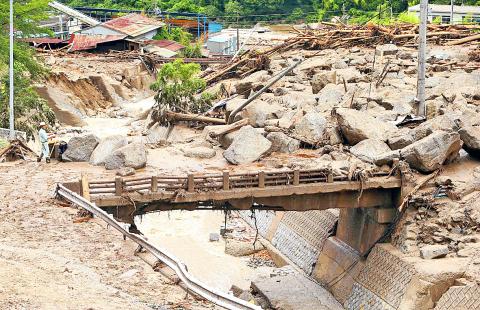Typhoon Neoguri slammed into the Japanese mainland yesterday, bringing widespread flooding, ripping trees from their roots and leaving houses half-buried under mud, as tens of thousands were urged to seek shelter.
The storm, which has left several people dead and a string of damage in its wake, caused havoc in many small communities as residents struggled to keep waves of dirty water from destroying their homes.
More than 500 houses in several prefectures were flooded due to the typhoon and heavy rain, according to the disaster management agency, with about 490,000 households urged to seek shelter.

Photo: AFP
“Water kept gushing into the house no matter how hard we tried to pour it out. We kept shoving out water all night,” said a woman in northern Yamagata Prefecture, where humid air brought by the typhoon caused huge downpours.
Officials warned of the risk of flooding and landslides as powerful winds and torrential rain batter the nation.
Neoguri hit the mainland yesterday morning near Akune City on Kyushu, which is home to 13 million people and lies next to Honshu, where major cities including Tokyo and Osaka are located.
The storm had crossed Kyushu by late morning and was forecast to make landfall on Honshu today.
Neoguri’s ferocity slowed somewhat overnight, packing gusts of up to 126kph as it moved east-northeast at 45kph.
Nearly 50 people have been injured in the wake of the storm, officials and reports said, while as many as five deaths have been linked to the typhoon.
The Japanese weather agency forecasts the typhoon to become a tropical storm by this afternoon.
More than 190 flights were canceled, while the government was expected to hold a meeting over how to protect against the force of nature.
The typhoon is likely to reach areas near the tsunami-crippled Fukushima Dai-ichi nuclear power plant by this morning. The site’s operator said workers were bracing for the storm.
Rivers and creeks on Honshu were already flooded, with a mudslide swallowing a house and killing a 12-year-old boy inside.

Authorities have detained three former Taiwan Semiconductor Manufacturing Co (TMSC, 台積電) employees on suspicion of compromising classified technology used in making 2-nanometer chips, the Taiwan High Prosecutors’ Office said yesterday. Prosecutors are holding a former TSMC engineer surnamed Chen (陳) and two recently sacked TSMC engineers, including one person surnamed Wu (吳) in detention with restricted communication, following an investigation launched on July 25, a statement said. The announcement came a day after Nikkei Asia reported on the technology theft in an exclusive story, saying TSMC had fired two workers for contravening data rules on advanced chipmaking technology. Two-nanometer wafers are the most

NEW GEAR: On top of the new Tien Kung IV air defense missiles, the military is expected to place orders for a new combat vehicle next year for delivery in 2028 Mass production of Tien Kung IV (Sky Bow IV) missiles is expected to start next year, with plans to order 122 pods, the Ministry of National Defense’s (MND) latest list of regulated military material showed. The document said that the armed forces would obtain 46 pods of the air defense missiles next year and 76 pods the year after that. The Tien Kung IV is designed to intercept cruise missiles and ballistic missiles to an altitude of 70km, compared with the 60km maximum altitude achieved by the Missile Segment Enhancement variant of PAC-3 systems. A defense source said yesterday that the number of

A bipartisan group of US representatives have introduced a draft US-Taiwan Defense Innovation Partnership bill, aimed at accelerating defense technology collaboration between Taiwan and the US in response to ongoing aggression by the Chinese Communist Party (CCP). The bill was introduced by US representatives Zach Nunn and Jill Tokuda, with US House Select Committee on the Chinese Communist Party Chairman John Moolenaar and US Representative Ashley Hinson joining as original cosponsors, a news release issued by Tokuda’s office on Thursday said. The draft bill “directs the US Department of Defense to work directly with Taiwan’s Ministry of National Defense through their respective

Tsunami waves were possible in three areas of Kamchatka in Russia’s Far East, the Russian Ministry for Emergency Services said yesterday after a magnitude 7.0 earthquake hit the nearby Kuril Islands. “The expected wave heights are low, but you must still move away from the shore,” the ministry said on the Telegram messaging app, after the latest seismic activity in the area. However, the Pacific Tsunami Warning System in Hawaii said there was no tsunami warning after the quake. The Russian tsunami alert was later canceled. Overnight, the Krasheninnikov volcano in Kamchatka erupted for the first time in 600 years, Russia’s RIA